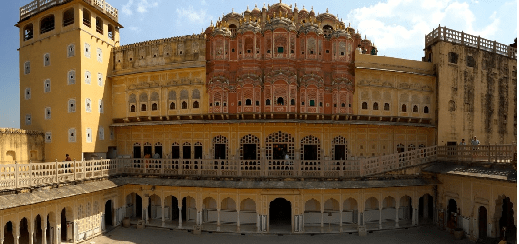Physical Address
304 North Cardinal St.
Dorchester Center, MA 02124

Hawa Mahal, meaning the “Palace of Winds,” was constructed in 1799 by Maharaja Sawai Pratap Singh, who belonged to the Kachhwaha Rajput dynasty. It was designed by Lal Chand Ustad, a renowned architect of that time. The palace was commissioned as an extension of the City Palace, located nearby, to serve a specific purpose.
During the 18th and 19th centuries, purdah (seclusion) was a significant aspect of the Rajput culture, where royal women were expected to maintain privacy and remain hidden from public view. Hawa Mahal was created to address this cultural practice while allowing the royal ladies to observe the city’s activities and processions from a safe and discreet vantage point.
Hawa Mahal Jaipur stands five stories tall and is built in the form of a high screen wall. The facade is adorned with intricate latticework, known as jharokhas, and features 953 small windows, which provide ventilation, allow the passage of cool air, and create a constant breeze throughout the palace. This design element not only facilitated air circulation but also prevented direct sunlight from entering the chambers, keeping the palace cool during the hot summers of Rajasthan.
The pink sandstone used in the construction of Hawa Mahal Jaipur reflects the predominant color of Jaipur, earning it the moniker “Pink City.” The palace’s honeycomb-like structure, with its numerous windows, creates a stunning visual spectacle, especially during sunrise and sunset when the soft golden light illuminates the facade, casting enchanting shadows.
Hawa Mahal Jaipur has witnessed significant historical events over the centuries. It served as a private retreat for the royal women and witnessed royal processions, festivals, and daily life unfold on the streets below. The palace has also stood witness to the changing times and the modernization of Jaipur.
Today, Hawa Mahal Jaipur stands as an architectural marvel and a symbol of Jaipur’s rich cultural heritage.
Visiting Hawa Mahal allows you to step back in time and appreciate the architectural grandeur and cultural significance of this remarkable palace.
Hawa Mahal Jaipur located in Jaipur, the capital city of Rajasthan. Here is the location information and how to reach Hawa Mahal:
Address: Hawa Mahal Rd, Badi Choupad, J.D.A. Market, Pink City, Jaipur, Rajasthan, India.
Hawa Mahal is situated in the Pink City area of Jaipur, near the Johari Bazaar. Here are a few ways to reach Hawa Mahal:
The nearest airport to Jaipur is Jaipur International Airport, which is approximately 13 kilometers away from Hawa Mahal. From the airport, you can hire a taxi or take a pre-paid taxi to reach Hawa Mahal directly.
Jaipur Junction is the main railway station in Jaipur, and it is well-connected to major cities in India. From the railway station, you can hire a taxi, auto-rickshaw, or take a local bus to reach Hawa Mahal, which is around 5 kilometers away.
Jaipur is well-connected by road networks, and there are regular bus services from various cities in Rajasthan and neighboring states. You can reach Jaipur by state-run buses, private buses, or even hire a taxi or self-drive to reach Hawa Mahal.
Once you are in Jaipur, you can use various local transportation options to reach Hawa Mahal. Auto-rickshaws, cycle-rickshaws, and taxis are readily available in the city. You can also consider hiring a local guide or joining a guided tour that includes Hawa Mahal in its itinerary.
Hawa Mahal Jaipur, a true architectural marvel nestled in the vibrant city of Jaipur.
Opening Hours & Fees
Opening Time: 9:00am. – 4:30p.m.
Entrance Fees: Indian: Rs.10, Foreigners: Rs.50
Tourist Pass/Composite Ticket covers 7 Jaipur monuments are available too
There are several attractions near Hawa Mahal that you can explore during your visit. Here are some popular nearby attractions:
City Palace: Located just a short distance from Hawa Mahal, the City Palace is a magnificent complex that showcases a blend of Rajput and Mughal architecture. Explore its grand courtyards, beautiful gardens, and visit the museum to admire a remarkable collection of royal artifacts.
Jantar Mantar: Adjacent to the City Palace, Jantar Mantar is an astronomical observatory built in the 18th century. It features a collection of fascinating astronomical instruments that were used for precise observations of celestial bodies.
Jal Mahal: Situated amidst the picturesque Man Sagar Lake, Jal Mahal is a stunning palace that appears to float on the water. Enjoy the serene ambiance and admire the unique architectural beauty of this water palace.
Amer Fort: Located about 11 kilometers from Hawa Mahal Jaipur, Amer Fort is a majestic hilltop fortress that offers panoramic views of the surrounding landscape. Explore its intricate palaces, courtyards, and the famous Sheesh Mahal (Hall of Mirrors).
Nahargarh Fort: Perched on the Aravalli Hills, Nahargarh Fort provides breathtaking views of Jaipur’s skyline.
Albert Hall Museum: Situated in Ram Niwas Garden, the Albert Hall Museum is the oldest museum in Rajasthan.
Bapu Bazaar and Johari Bazaar: Indulge in some shopping at the vibrant Bapu Bazaar and Johari Bazaar, known for their bustling markets offering a wide range of traditional Rajasthani handicrafts, jewelry, textiles, and more.
The best time to visit Hawa Mahal is during the cooler months of October to March. The weather is pleasant, making it more comfortable for sightseeing. The early morning hours are particularly enjoyable, with milder temperatures and fewer crowds.
Try to avoid visiting during the peak summer months (April to June) when temperatures can soar to very high levels, making outdoor activities less pleasant.
Remember, these tips can help you have a more enjoyable and enriching experience while visiting the iconic Hawa Mahal in Jaipur.
Remember to check the official timings of Hawa Mahal Jaipur before your visit, as the opening and closing hours may vary. It’s also recommended to dress comfortably, wear sunscreen, and carry a hat or umbrella, as the area around Hawa Mahal can get quite sunny and warm.
Enjoy your visit to Hawa Mahal and immerse yourself in the historical and architectural splendor of this iconic landmark in Jaipur.